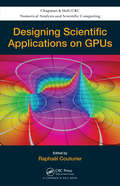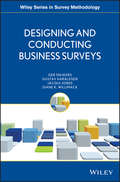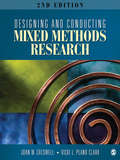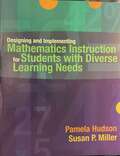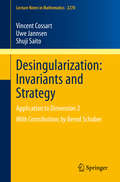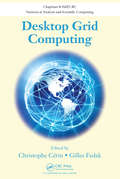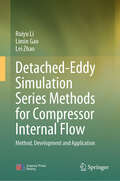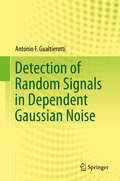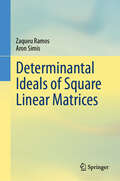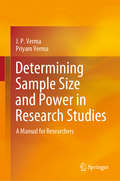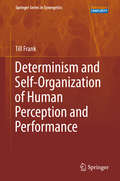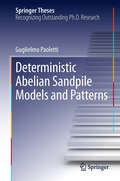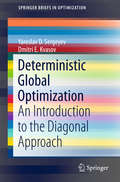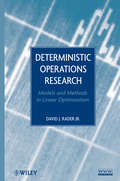- Table View
- List View
Designing Scientific Applications on GPUs (Chapman & Hall/CRC Numerical Analysis and Scientific Computing Series)
by Raphaël CouturierMany of today's complex scientific applications now require a vast amount of computational power. General purpose graphics processing units (GPGPUs) enable researchers in a variety of fields to benefit from the computational power of all the cores available inside graphics cards.Understand the Benefits of Using GPUs for Many Scientific Applications
Designing and Conducting Business Surveys
by Ger Snijkers Gustav Haraldsen Jacqui Jones Diane K. WillimackDesigning and Conducting Business Surveys provides a coherent overview of the business survey process, from start to finish. It uniquely integrates an understanding of how businesses operate, a total survey error approach to data quality that focuses specifically on business surveys, and sound project management principles. The book brings together what is currently known about planning, designing, and conducting business surveys, with producing and disseminating statistics or other research results from the collected data. This knowledge draws upon a variety of disciplines such as survey methodology, organizational sciences, sociology, psychology, and statistical methods. The contents of the book formulate a comprehensive guide to scholarly material previously dispersed among books, journal articles, and conference papers. This book provides guidelines that will help the reader make educated trade-off decisions that minimize survey errors, costs, and response burden, while being attentive to survey data quality. Major topics include: * Determining the survey content, considering user needs, the business context, and total survey quality * Planning the survey as a project * Sampling frames, procedures, and methods * Questionnaire design and testing for self-administered paper, web, and mixed-mode surveys * Survey communication design to obtain responses and facilitate the business response process * Conducting and managing the survey using paradata and project management tools * Data processing, including capture, editing, and imputation, and dissemination of statistical outputs Designing and Conducting Business Surveys is an indispensable resource for anyone involved in designing and/or conducting business or organizational surveys at statistical institutes, central banks, survey organizations, etc. ; producing statistics or other research results from business surveys at universities, research organizations, etc. ; or using data produced from business surveys. The book also lays a foundation for new areas of research in business surveys.
Designing and Conducting Mixed Methods Research
by John W. Creswell Vicki L. Plano ClarkA practical, how-to guide to designing mixed methods studiesCombining the latest thinking about mixed methods research designs with practical, step-by-step guidance, the Second Edition of Designing and Conducting Mixed Methods Research now covers six major mixed methods designs. Authors John W. Creswell and Vicki L. Plano Clark walk readers through the entire research process, from formulating questions to designing, collecting data, and interpreting results and include updated examples from published mixed methods studies drawn from the social, behavioral, health, and education disciplines.Intended AudienceThis text is intended for use in Intermediate/Advanced Research Methods, Mixed Methods, Research Design, and Social Research Methods courses across the social and behavioral sciences.
Designing and Conducting a Forest Inventory - case: 9th National Forest Inventory of Finland
by Matti Katila Juha Heikkinen Helena M. Henttonen Tarja Tuomainen Nina Vainikainen Antti Ihalainen Helena Mäkelä Erkki TomppoThis book demonstrates in detail all phases of the 9th National Forest Inventory of Finland (1996-2003): the planning of the sampling design, measurements, estimation methods and results. The inventory knowledge accumulated during almost one hundred years is consolidated in the book. The purpose of the numerous examples of results is to demonstrate the diversity of the estimates and content of a national forest inventory. The most recent results include the assessment of the indicators describing the biodiversity of forests. The Finnish NFI has been and is a model for many countries worldwide. The methods and results of the book are set in the international context and are applicable globally. The book provides a valuable information source for countries, institutions and researchers planning own inventories as well as modifying the existing ones, or seeking the applicable definitions and estimation methods to use in their own inventories.
Designing and Implementing Mathematics Instruction for Students with Diverse Learning Needs
by Susan Miller Pamela HudsonThis exciting new book integrates the explicit teaching practices that have proven effective for students with disabilities with the NCTM math standards that dominant current mathematics practices in the United States . <p><p>In Part 1 of the book, teachers learn the fundamentals of mathematics assessment and instructional design for conceptual, declarative knowledge, procedural, and problem-solving lessons. In Part 2, the detailed scope and sequence charts, along with instructional guidelines keyed to the objectives, provide teachers with specific guidelines for assessment and design. <p><p>The curriculum-based assessment chapter (Ch. 2) helps teachers group students for instruction, place in curriculum, monitor performance, and make data based decisions. Content coverage of all five NCTM content standards provides teachers the support needed to access the general education curriculum and help their students meet annual yearly progress expectations (Chapters 7 ― 15). Detailed scope and sequence charts provide a valuable resource for assessing, planning, and designing instruction (Chapters 7-15). Instructional design discussion includes four domains: concepts, declarative knowledge, problem solving, and procedural knowledge. When teachers understand the function of the instruction, their effectiveness and efficiency are enhanced (Chapters 3-15). Integration of explicit teaching practices with NCTM approach helps teachers maintain practices that work for students with diverse needs while integrating reformed-based mathematics practices (in Chapters 1, 7-15). Detailed guidelines, including scripted lessons, on HOW to design and deliver effective instruction. These sample lessons illustrate how to apply the explicit teaching sequence to various content areas and provide examples for preservice and inservice teachers to use when developing their own lessons.
Designing and Using Organizational Surveys
by Allan H. Church Janine WaclawskiThis book will serve as an excellent primer for executives and practitioners who are about to embark on an organizational survey
Designing for Human Intelligence in an Artificial Intelligence World: Understanding Human Cognition to Design for Humans
by Rebecca Baker Jerome L. RekartHow we think and react has a direct impact on experience design, but often designers don't understand the "whys" behind their best practices, leaving them at risk for misusing or underutilizing those designs. Similarly, psychologists/neuroscientists don't understand the design decisions that their science is informing and how they might be leveraged further. This book explores how neuroscience and cognitive psychology inform experience design, within the modern context of research and technological advances. With a conversational and playful tone, this book begins by grounding you in research and AI. That foundation then allows you to expand your repertoire through chapters on design-relevant cognitive phenomena such as memory, learning, and perception. By delving into how our brains handle these processes and how our designs can effectively (or ineffectively) leverage them, the book follows a journey that weaves academic learning with practical, real-world applications and examples. With the widespread availability of generative AI tools, understanding the intersection of human cognition and design and how that knowledge can be used to build a bridge between the brain and the software has become even more critical. By understanding the brain and human behavior more completely, designers will be able to effectively use AI as an accelerator for tactical projects and provide the context that is unique to the human ability to understand the "why.&”
Designing, Conducting, and Publishing Quality Research in Mathematics Education (Research in Mathematics Education)
by Keith R. LeathamThe purpose of this book is to collect, organize and disseminate collective wisdom with respect to designing, conducting, and publishing quality research in mathematics education. This wisdom will be gleaned from among those who, over the past several decades, have been instrumental in guiding the field in the pursuit of excellence in mathematics education research—insightful editors, educative reviewers, prolific writers, and caring mentors. Each chapter is written to the novice researcher with the intent of aiding them in avoiding common pitfalls, navigating difficult intellectual terrain, and understanding that they are not alone in experiencing rejection, frustration, confusion, and doubt. This book differs from existing literature in the sense that it is written about the enterprise of designing, conducting and publishing research in mathematics education as opposed to being reports of the results of such work. It also differs in the sense that it is written with the intent to mentor the rising generation as opposed to capture the state of the field (as would happen in a handbook, for example). It is written for the express purpose of helping the field work collectively to aid in the often isolated enterprise of mentoring new researchers. The primary audience is a potentially wide one: graduate students, novice researchers, graduate faculty, advisors, and mentors – or anyone seeking to improve their own abilities to design, conduct, and publish quality research in mathematics education.
Desingularization: Application to Dimension 2 (Lecture Notes in Mathematics #2270)
by Vincent Cossart Uwe Jannsen Shuji SaitoThis book provides a rigorous and self-contained review of desingularization theory. Focusing on arbitrary dimensional schemes, it discusses the important concepts in full generality, complete with proofs, and includes an introduction to the basis of Hironaka’s Theory. The core of the book is a complete proof of desingularization of surfaces; despite being well-known, this result was no more than folklore for many years, with no existing references. Throughout the book there are numerous computations on standard bases, blowing ups and characteristic polyhedra, which will be a source of inspiration for experts exploring bigger dimensions. Beginners will also benefit from a section which presents some easily overlooked pathologies.
Desktop Grid Computing
by Christophe Cérin Gilles FedakDesktop Grid Computing presents common techniques used in numerous models, algorithms, and tools developed during the last decade to implement desktop grid computing. These techniques enable the solution of many important sub-problems for middleware design, including scheduling, data management, security, load balancing, result certification, and f
Dessins d'Enfants on Riemann Surfaces
by Gareth A. Jones Jürgen WolfartThis volume provides an introduction to dessins d'enfants and embeddings of bipartite graphs in compact Riemann surfaces. The first part of the book presents basic material, guiding the reader through the current field of research. A key point of the second part is the interplay between the automorphism groups of dessins and their Riemann surfaces, and the action of the absolute Galois group on dessins and their algebraic curves. It concludes by showing the links between the theory of dessins and other areas of arithmetic and geometry, such as the abc conjecture, complex multiplication and Beauville surfaces. Dessins d'Enfants on Riemann Surfaces will appeal to graduate students and all mathematicians interested in maps, hypermaps, Riemann surfaces, geometric group actions, and arithmetic.
Detached-Eddy Simulation Series Methods for Compressor Internal Flow: Method, Development and Application
by Lei Zhao Ruiyu Li Limin GaoThis book concentrates on high-fidelity numerical methods for predicting internal flows within aeroengines’ compressors. A distinctive features of this work is the establishment of a comprehensive research framework. Specifically, it starts with engineering application requirements and integrates high-performance parallel algorithms to develop detached eddy simulation (DES)-series methods tailored to the needs of compressor design. Additionally, it encompasses the development of data analysis methods suitable for handling the "vast" amounts of high-fidelity unsteady flow data in compressors and the high spatial resolution experimental results. This book takes us from making the intricate details of compressor flow field structures "visible" to “explainable”. Another noteworthy aspect of this book is its practical orientation, seamlessly intergrating theoretical concepts with practical applications. Herein, it addresses three major engineering problems in detail and elucidates the technical approaches involving advanced numerical methods and data analysis techniques for solving these physical problems. The book highlights the challenging issues associated with complex internal flows in compressors, the governing equations for DES-series methods, and the implementation strategies for numerical simulations of internal compressor flows. They also delve into data-driven analysis methods for unsteady flow field data, high-fidelity numerical simulations of flow in the blade root region of compressors, dynamic flow capture methods in the tip region of compressor blades, and simulation and analysis of flow fields in inlet distortion generators. This book serves as a valuable reference for researchers and engineering professionals in the aerospace, computational fluid dynamics, and high-performance turbomachinery fields. Additionally, it can be used as a specialized textbook for doctoral and master's students in disciplines such as aerospace science and technology, power engineering, and engineering thermophysics.
Detection and Estimation for Communication and Radar Systems
by Kung Yao Flavio Lorenzelli Chiao-En ChenCovering the fundamentals of detection and estimation theory, this systematic guide describes statistical tools that can be used to analyze, design, implement and optimize real-world systems. Detailed derivations of the various statistical methods are provided, ensuring a deeper understanding of the basics. Packed with practical insights, it uses extensive examples from communication, telecommunication and radar engineering to illustrate how theoretical results are derived and applied in practice. A unique blend of theory and applications and over 80 analytical and computational end-of-chapter problems make this an ideal resource for both graduate students and professional engineers.
Detection of Random Signals in Dependent Gaussian Noise
by Antonio F. GualtierottiThe book presents the necessary mathematical basis to obtain and rigorously use likelihoods for detection problems with Gaussian noise. To facilitate comprehension the text is divided into three broad areas - reproducing kernel Hilbert spaces, Cramér-Hida representations and stochastic calculus - for which a somewhat different approach was used than in their usual stand-alone context. One main applicable result of the book involves arriving at a general solution to the canonical detection problem for active sonar in a reverberation-limited environment. Nonetheless, the general problems dealt with in the text also provide a useful framework for discussing other current research areas, such as wavelet decompositions, neural networks, and higher order spectral analysis. The structure of the book, with the exposition presenting as many details as necessary, was chosen to serve both those readers who are chiefly interested in the results and those who want to learn the material from scratch. Hence, the text will be useful for graduate students and researchers alike in the fields of engineering, mathematics and statistics.
Detectors, Reference Frames, and Time (Springer Theses)
by Alexander R. SmithThis thesis uses the tools of quantum information science to uncover fascinating new insights about the intersection of quantum theory and relativity. It is divided into three self-contained parts, the first of which employs detector models to investigate how the information content of quantum fields depends on spacetime curvature and global spacetime topology. The behavior of Unruh-DeWitt detectors on curved spacetimes are investigated, following which these detectors are used to probe the vacuum state of a scalar field in various topologies. This leads to a generalization of the entanglement harvesting protocol involving detectors in arbitrary curved spacetimes admitting a Wightman function. The second part extends the theory of quantum reference frames to those associated with noncompact groups. Motivated by the pursuit of a relational relativistic quantum theory where the group of reference frames is the Poincaré group, the author then generalizes a communication protocol between two parties lacking a common reference frame to the scenario where the group of transformations of their reference frame is a one-dimensional noncompact Lie group. Finally, the third part, inspired by theories of quantum gravity, generalizes the conditional probability interpretation of time, a proposed mechanism for time to emerge from a fundamentally timeless Universe. While the conditional probability interpretation of time is based upon conditioning a solution to the Wheeler-DeWitt equation on a subsystem of the universe that acts a clock, the author extends this approach to include an interaction between the system being used as a clock and a system whose evolution the clock is tracking.
Determinantal Ideals of Square Linear Matrices
by Aron Simis Zaqueu RamosThis book explores determinantal ideals of square matrices from the perspective of commutative algebra, with a particular emphasis on linear matrices. Its content has been extensively tested in several lectures given on various occasions, typically to audiences composed of commutative algebraists, algebraic geometers, and singularity theorists.Traditionally, texts on this topic showcase determinantal rings as the main actors, emphasizing their properties as algebras. This book follows a different path, exploring the role of the ideal theory of minors in various situations—highlighting the use of Fitting ideals, for example. Topics include an introduction to the subject, explaining matrices and their ideals of minors, as well as classical and recent bounds for codimension. This is followed by examples of algebraic varieties defined by such ideals. The book also explores properties of matrices that impact their ideals of minors, such as the 1-generic property, explicitly presenting a criterion by Eisenbud. Additionally, the authors address the problem of the degeneration of generic matrices and their ideals of minors, along with applications to the dual varieties of some of the ideals.Primarily intended for graduate students and scholars in the areas of commutative algebra, algebraic geometry, and singularity theory, the book can also be used in advanced seminars and as a source of aid. It is suitable for beginner graduate students who have completed a first course in commutative algebra.
Determining Sample Size and Power in Research Studies: A Manual for Researchers
by J. P. Verma Priyam VermaThis book addresses sample size and power in the context of research, offering valuable insights for graduate and doctoral students as well as researchers in any discipline where data is generated to investigate research questions. It explains how to enhance the authenticity of research by estimating the sample size and reporting the power of the tests used. Further, it discusses the issue of sample size determination in survey studies as well as in hypothesis testing experiments so that readers can grasp the concept of statistical errors, minimum detectable difference, effect size, one-tail and two-tail tests and the power of the test. The book also highlights the importance of fixing these boundary conditions in enhancing the authenticity of research findings and improving the chances of research papers being accepted by respected journals. Further, it explores the significance of sample size by showing the power achieved in selected doctoral studies. Procedure has been discussed to fix power in the hypothesis testing experiment. One should usually have power at least 0.8 in the study because having power less than this will have the issue of practical significance of findings. If the power in any study is less than 0.5 then it would be better to test the hypothesis by tossing a coin instead of organizing the experiment. It also discusses determining sample size and power using the freeware G*Power software, based on twenty-one examples using different analyses, like t-test, parametric and non-parametric correlations, multivariate regression, logistic regression, independent and repeated measures ANOVA, mixed design, MANOVA and chi-square.
Determinism and Self-Organization of Human Perception and Performance (Springer Series in Synergetics)
by Till FrankThis book discusses human perception and performance within the framework of the theory of self-organizing systems. To that end, it presents a variety of phenomena and experimental findings in the research field, and provides an introduction to the theory of self-organization, with a focus on amplitude equations, order parameter and Lotka-Volterra equations. The book demonstrates that relating the experimental findings to the mathematical models provides an explicit account for the causal nature of human perception and performance. In particular, the notion of determinism versus free will is discussed in this context. The book is divided into four main parts, the first of which discusses the relationship between the concept of determinism and the fundamental laws of physics. The second part provides an introduction to using the self-organization approach from physics to understand human perception and performance, a strategy used throughout the remainder of the book to connect experimental findings and mathematical models. In turn, the third part of the book focuses on investigating performance guided by perception: climbing stairs and grasping tools are presented in detail. Perceptually relevant bifurcation parameters in the mathematical models are also identified, e.g. in the context of walk-to-run gait transitions. Chains of perceptions and actions together with their underlying mechanisms are then presented, and a number of experimental phenomena – such as selective attention, priming, child play, bistable perception, retrieval-induced forgetting, functional fixedness and memory effects exhibiting hysteresis with positive or negative sign – are discussed. Human judgment making, internal experiences such as dreaming and thinking, and Freud’s concept of consciousness are also addressed. The fourth and last part of the book explores several specific topics such as learning, social interactions between two people, life trajectories, and applications in clinical psychology. In particular, episodes of mania and depression under bipolar disorder, perception under schizophrenia, and obsessive-compulsive rituals are discussed. This book is intended for researchers and graduate students in psychology, physics, applied mathematics, kinesiology, and the sport sciences who want to learn about the foundations of the field. Written for a mixed audience, the experiments and concepts are presented using non-technical language throughout. In addition, each chapter includes more advanced sections for modelers in the fields of physics and applied mathematics.
Deterministic Abelian Sandpile Models and Patterns
by Guglielmo PaolettiThe model investigated in this work, a particular cellular automaton with stochastic evolution, was introduced as the simplest case of self-organized-criticality, that is, a dynamical system which shows algebraic long-range correlations without any tuning of parameters. The author derives exact results which are potentially also interesting outside the area of critical phenomena. Exact means also site-by-site and not only ensemble average or coarse graining. Very complex and amazingly beautiful periodic patterns are often generated by the dynamics involved, especially in deterministic protocols in which the sand is added at chosen sites. For example, the author studies the appearance of allometric structures, that is, patterns which grow in the same way in their whole body, and not only near their boundaries, as commonly occurs. The local conservation laws which govern the evolution of these patterns are also presented. This work has already attracted interest, not only in non-equilibrium statistical mechanics, but also in mathematics, both in probability and in combinatorics. There are also interesting connections with number theory. Lastly, it also poses new questions about an old subject. As such, it will be of interest to computer practitioners, demonstrating the simplicity with which charming patterns can be obtained, as well as to researchers working in many other areas.
Deterministic Extraction from Weak Random Sources
by Ariel GabizonA deterministic extractor is a function that extracts almost perfect random bits from a weak random source. In this research monograph the author constructs deterministic extractors for several types of sources. A basic theme in this work is a methodology of recycling randomness which enables increasing the output length of deterministic extractors to near optimal length. The author's main work examines deterministic extractors for bit-fixing sources, deterministic extractors for affine sources and polynomial sources over large fields, and increasing the output length of zero-error dispersers. This work will be of interest to researchers and graduate students in combinatorics and theoretical computer science.
Deterministic Global Optimization
by Yaroslav D. Sergeyev Dmitri E. KvasovThis book begins with a concentrated introduction into deterministic global optimization and moves forward to present new original results from the authors who are well known experts in the field. Multiextremal continuous problems that have an unknown structure with Lipschitz objective functions and functions having the first Lipschitz derivatives defined over hyperintervals are examined. A class of algorithms using several Lipschitz constants is introduced which has its origins in the DIRECT (DIviding RECTangles) method. This new class is based on an efficient strategy that is applied for the search domain partitioning. In addition a survey on derivative free methods and methods using the first derivatives is given for both one-dimensional and multi-dimensional cases. Non-smooth and smooth minorants and acceleration techniques that can speed up several classes of global optimization methods with examples of applications and problems arising in numerical testing of global optimization algorithms are discussed. Theoretical considerations are illustrated through engineering applications. Extensive numerical testing of algorithms described in this book stretches the likelihood of establishing a link between mathematicians and practitioners. The authors conclude by describing applications and a generator of random classes of test functions with known local and global minima that is used in more than 40 countries of the world. This title serves as a starting point for students, researchers, engineers, and other professionals in operations research, management science, computer science, engineering, economics, environmental sciences, industrial and applied mathematics to obtain an overview of deterministic global optimization.
Deterministic Operations Research
by David J. RaderUniquely blends mathematical theory and algorithm design for understanding and modeling real-world problemsOptimization modeling and algorithms are key components to problem-solving across various fields of research, from operations research and mathematics to computer science and engineering. Addressing the importance of the algorithm design process. Deterministic Operations Research focuses on the design of solution methods for both continuous and discrete linear optimization problems. The result is a clear-cut resource for understanding three cornerstones of deterministic operations research: modeling real-world problems as linear optimization problem; designing the necessary algorithms to solve these problems; and using mathematical theory to justify algorithmic development.Treating real-world examples as mathematical problems, the author begins with an introduction to operations research and optimization modeling that includes applications form sports scheduling an the airline industry. Subsequent chapters discuss algorithm design for continuous linear optimization problems, covering topics such as convexity. Farkas' Lemma, and the study of polyhedral before culminating in a discussion of the Simplex Method. The book also addresses linear programming duality theory and its use in algorithm design as well as the Dual Simplex Method. Dantzig-Wolfe decomposition, and a primal-dual interior point algorithm. The final chapters present network optimization and integer programming problems, highlighting various specialized topics including label-correcting algorithms for the shortest path problem, preprocessing and probing in integer programming, lifting of valid inequalities, and branch and cut algorithms.Concepts and approaches are introduced by outlining examples that demonstrate and motivate theoretical concepts. The accessible presentation of advanced ideas makes core aspects easy to understand and encourages readers to understand how to think about the problem, not just what to think. Relevant historical summaries can be found throughout the book, and each chapter is designed as the continuation of the "story" of how to both model and solve optimization problems by using the specific problems-linear and integer programs-as guides. The book's various examples are accompanied by the appropriate models and calculations, and a related Web site features these models along with MapleTM and MATLAB® content for the discussed calculations.Thoroughly class-tested to ensure a straightforward, hands-on approach, Deterministic Operations Research is an excellent book for operations research of linear optimization courses at the upper-undergraduate and graduate levels. It also serves as an insightful reference for individuals working in the fields of mathematics, engineering, computer science, and operations research who use and design algorithms to solve problem in their everyday work.
Deterministic and Stochastic Optimal Control and Inverse Problems
by Baasansuren JadambaInverse problems of identifying parameters and initial/boundary conditions in deterministic and stochastic partial differential equations constitute a vibrant and emerging research area that has found numerous applications. A related problem of paramount importance is the optimal control problem for stochastic differential equations. This edited volume comprises invited contributions from world-renowned researchers in the subject of control and inverse problems. There are several contributions on optimal control and inverse problems covering different aspects of the theory, numerical methods, and applications. Besides a unified presentation of the most recent and relevant developments, this volume also presents some survey articles to make the material self-contained. To maintain the highest level of scientific quality, all manuscripts have been thoroughly reviewed.
Deterministic, Stochastic and Thermodynamic Modelling of some Interacting Species (Forum for Interdisciplinary Mathematics)
by Guruprasad SamantaThis book presents the understanding of how the different forms of regulatory mechanisms, like birth and death, competition, consumption and the like, result in changes in the stability and dynamics of ecological systems. It deals with a profound and unique insight into the mathematical richness of basic ecological models. Organised into eight chapters, the book discusses the models of mathematical ecology, the dynamical models of single-species system in a polluted environment, the dynamical behaviour of different nonautonomous two species systems in a polluted environment, the influence of environmental noise in Gompertzian and logistic growth models, stability behaviour in randomly fluctuating versus deterministic environments of two interacting species, stochastic analysis of a demographic model of urbanization and stability behaviour of a social group by means of loop analysis, thermodynamic criteria of stability and stochastic criteria of stability. The book will be useful to the researchers and graduate students who wish to pursue research in mathematical ecology.
Deterministic, Stochastic, and Deep Learning Methods for Computational Electromagnetics
by Wei CaiThis book provides a well-balanced and comprehensive picture based on clear physics, solid mathematical formulation, and state-of-the-art useful numerical methods in deterministic, stochastic, deep neural network machine learning approaches for computer simulations of electromagnetic and transport processes in biology, microwave and optical wave devices, and nano-electronics. Computational research has become strongly influenced by interactions from many different areas including biology, physics, chemistry, engineering, etc. A multifaceted approach addressing the interconnection among mathematical algorithms and physical foundation and application is much needed to prepare graduate students and researchers in applied mathematics and sciences and engineering for innovative advanced computational research in many applications areas, such as biomolecular solvation in solvents, radar wave scattering, the interaction of lights with plasmonic materials, plasma physics, quantum dots, electronic structure, current flows in nano-electronics, and microchip designs, etc.
